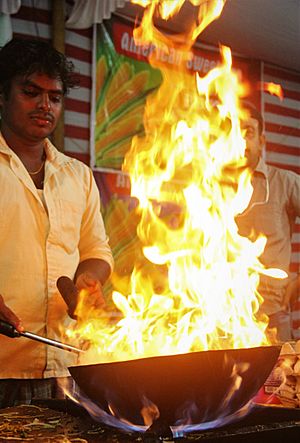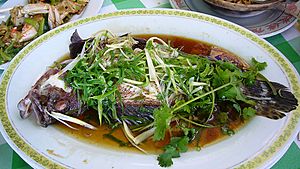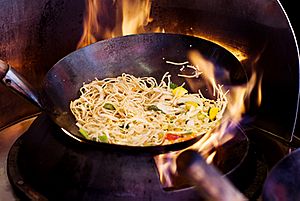Chinese cooking techniques facts for kids
Chinese cooking techniques are special ways of preparing food that have been used in Chinese cuisine for a very long time. These methods can be grouped into two main types: those that use just one cooking style, and those that combine different wet and dry cooking steps.
Contents
Cooking with One Method
Many Chinese cooking techniques use only one main way of heating food or one action.
Wet Cooking Methods
Wet-heat cooking means using water or other liquids to cook food. These methods are very common in Chinese cooking. The Chinese word zhǔ (煮) often refers to these techniques, and it can even mean "to cook" in general.
Quick Wet Cooking
Some wet-heat methods cook food very quickly by putting it into hot liquid:
- Braising (Shāo Chinese: 烧): This involves cooking ingredients over medium heat in a small amount of sauce or broth. It simmers for a short time until done. When soy sauce is used, it's called hóngshāo (红燒), which means "red cooking."
- Quick Boiling (Cuān or Zhá 汆 or 煠): You add ingredients and seasonings to boiling water or broth. The dish is served right away once everything boils again.
- Blanching (Chāo or Tàng 焯 or Chinese: 烫): This means partly cooking raw food by quickly dipping it in boiling water or broth. Sometimes, it's then put into cold water.
Longer Wet Cooking
Other wet-heat methods cook food for a longer time:
- Bake Stewing (Wēi 煨): This is a slow way of cooking broth and other ingredients in a ceramic pot. The pot is placed in or near hot embers.
- Steam Stewing (Mèn 焖): Food is cooked with liquid, like water or soup. A tight-fitting lid is used until the liquid is soaked up.
- Gradual Simmering (Dùn Chinese: 炖): Ingredients are added to cold water with seasonings. The mixture slowly comes to a gentle, long boil. This is also known as double steaming because of the special pots often used.
- Slow Red Cooking (Lǔ Chinese: 卤): Food is cooked for a long time over steady heat. The ingredients are fully covered in a strong-flavored broth, usually made with soy sauce. This is different from, but sometimes confused with, Hóng shāo.
- Decoction (Áo 熬): This means cooking slowly to get nutrients into the simmering liquid. It's often used in Chinese herbology to make herbal remedies.
Steaming Food
Steaming is a wet cooking method that has been used in Chinese cooking for thousands of years. Even in ancient times, people would steam extra food over a pot where other food was already boiling.
- Steaming (Zhēng or Xún 蒸 or 燖): Food is cooked completely using the steam from boiling water.
- Distillation Simmering (Chún 醇): This method uses a special lidded pot called a steam-pot (Chinese: 汽鍋). It has a chimney inside that is also covered. Food is placed in the pot without any cooking liquid. The pot sits on top of another pot of boiling water. Steam from the bottom pot rises, turns into hot water in the top pot, and cooks the food while creating a soup. This is used for "pure" and healthy foods like steam-pot chicken.
Dry Cooking Methods
Air-based Cooking
These methods cook food in hot, dry spaces like an oven or a heated empty wok:
- Baking or Roasting (Kǎo 烤): Food is cooked by hot air moving around it, or by direct heat, inside an enclosed space.
- Grilling (zhì [kǎo] 炙[烤]): Food is cooked directly over heat, usually on skewers over charcoal.
- Smoking (Xūn 熏): Food is cooked with direct heat and smoke. The smoke often comes from burning sugar or tea.
Oil-based Cooking
Using oil to cook is one of the most common ways to prepare food in Chinese cuisine:
- Deep Frying or Frying (Zhá 炸): Food is fully or partly covered and cooked in hot oil or fat.
- Pan Frying (Jiān 煎): Food is cooked in a pan with a thin layer of oil or liquid, allowing it to brown.
- Stir Frying or High Heat Sautéing (Chǎo 炒): Ingredients are cooked quickly in hot oil while being stirred constantly until done. This is often called stir frying in English. It uses higher heat than regular sautéing.
- Flash-frying or High Heat Stir Frying ([Yóu]Bào [油]爆): This involves cooking with a lot of hot oil, sauces (Chinese: 酱爆; pinyin: jiàng bào), or broth (Chinese: 汤爆; pinyin: tāng bào) at very high heat. The ingredients are tossed quickly in a wok until cooked.
Types of Stir Frying
There are five different ways to stir-fry:
- Plain Stir-fry (qīngchǎo 清炒): Stir-frying just one main ingredient with flavorings and sauces. If garlic is used, it's called 蒜炒 (suànchǎo).
- Dry Stir-fry (biānchǎo 煸炒): Stir-frying a mix of meat (protein) and vegetables with a tiny bit of liquid.
- Moist Stir-fry (huáchǎo 滑炒): Stir-frying a mix of meat and vegetables with a sauce that is like gravy.
- Dry-fry (gānbiān 干煸): Scorching food in oil before stir-frying, without adding any water.
- Scramble Stir-fry (ruǎnchǎo 软炒): A method used to make egg custard.
Cooking Without Heat
Some food preparation methods do not involve heating the ingredients:
- Dressing (Bàn 拌): Mixing raw or plain cooked ingredients with seasonings. It's served right away, similar to tossing a salad with dressing.
- Marinating or Pickling (Yān or Jiàng 腌 or 醬): Soaking ingredients in salt, soy sauce, or soy pastes. This is used to make pickles or to prepare food before cooking it further.
- Jellifying (Dòng 冻): Quickly cooling a broth that contains gelatin or agarose to make a jelly, like aspic.
- Velveting (Guò yóu 过油): This method involves marinating meat in corn starch and other ingredients before cooking. It gives the meat a very smooth, "velvety" texture.
Combination Cooking Methods

Several Chinese cooking techniques use more than one step. Each combination has its own special name:
- Dòng (凍): This technique is used to make aspic (a savory jelly) and other gelatin desserts.
- Hùi (燴): Dishes made with this technique are usually finished by making the sauce thicker with starch (Chinese: 勾芡; pinyin: gōuqiàn).
- Liū (溜): This technique is often used for meat and fish. Pre-fried tofu is also made especially for this purpose.
- Mēn (燜):





